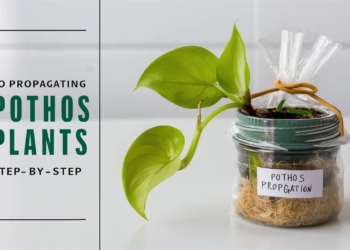So, you’ve got a snake plant, also known as Sansevieria, and you’re thinking, “How can I multiply this green delight?” Fear not, my fellow plant enthusiast! We’re about to embark on a thrilling journey into the fascinating realm of propagate a snake plant. From leaf cuttings to rhizome division, we’re covering it all. Get ready to unleash your inner plant parent ninja and watch those snake plants multiply like rabbits!
Table Of Contents
Propagate A Snake Plant: Getting Started
Propagating a snake plant is a gratifying gardening task that demands meticulous planning and consideration. This section serves as your guide, providing insights into the ideal time for propagation and essential tools required for a successful outcome.
When to Propagate a Snake Plant
The opportune period for propagation aligns with the plant’s active growth phase, typically in spring and early summer. This is when the plant channels robust energy into successful propagation. Avoid propagation during the dormant winter months when the plant prioritizes root development over leaf growth.
Best Time to Propagate a Snake Plant
Choose the early morning or late afternoon for propagation to minimize stress on the plant, optimizing the chances of successful propagation. Steer clear of midday heat, as it can lead to excessive moisture loss.
How Do I Know If My Snake Plant Is Ready to Be Propagated?
Look for these indicators:
- Mature, healthy-looking leaves, at least 4-6 inches tall.
- Visible pups or offsets that can be separated and propagated independently.
- A robust and healthy root system.

Method 1: Leaf Cuttings – The Plant Ninja Move
Grab Your Tools, Plant Samurai!
Alright, green thumbs, put on your gardening gloves and gather your weapons:
- Sharp scissors or gardening shears: Precision is key!
- A healthy snake plant: Pick one with robust leaves and no signs of disease or pests.
- Potting mix: Something light and airy to give your snake plant babies the best start.
The Heist: Stealing Those Leaves
- Select your victim – I mean, leaf: Choose a mature, healthy leaf and cut it close to the soil line. Think of it as a clean break-up!
- Chop it up: Cut the leaf into 2-3 inch sections. Each section is a potential plant in the making. Talk about a plant crime spree!
- Dry them out: Let the cut ends dry for a day or two. It’s like a plant spa day – necessary for the best results.
Plant Parenthood 101
- Stick ’em in the soil: Plant your leaf cuttings in the potting mix, burying them about an inch deep. This is where the magic happens!
- Keep it moist: Water the soil regularly, but don’t drown the little rebels. They like to be a bit rebellious, not waterlogged.
The Verdict
In a few weeks, you’ll notice tiny shoots emerging from the soil. Congratulations! You’ve just performed the ancient art of leaf cutting propagation. Now, go brag to your plant buddies about your newfound plant ninja skills!
Pros
- No need to keep cuttings in water.
- Suitable for mixing different varieties in one pot.
Cons
- New plants may lack variegations.
- Root growth isn’t visible unless you dig up the plant.
Method 2: Division – The Splitting Technique
Gather Your Plant Troops
- A mature snake plant: Find one that’s been around the block a few times. Experience matters!
- Gloves: Snake plants can be a bit prickly. Protect those digits!
The Operation
- Unearth the beast: Carefully remove the snake plant from its pot. It’s time for a little plant surgery!
- Inspect the roots: Identify natural divisions in the rhizome, those fleshy, underground stems. They’re like the plant’s secret agents!
Splitting the Loot
- Slice and dice: Use a sharp knife or your hands to separate the rhizomes into distinct plant sections at least three rhizomes. Imagine you’re dividing a cake, but with more soil and fewer calories.
- Plant the divisions: Re-pot each section into its own container filled with fresh potting mix. Give them some space – plants need their personal bubble too!
The Aftermath
Water your new snake plant recruits and place them in a cozy spot with indirect light. Watch them grow into independent, thriving green machines. You’re not just a plant parent; you’re a plant general leading your army of snake plants into the botanical battlefield!
Pros
- New leaves may exhibit variegation.
- Faster than leaf propagation.
Cons
- Requires a large plant with multiple growths.

Method 3: Rhizome Offsets – The Underground Rebellion
Tools of the Trade
- A mature snake plant: Once again, experience is key!
- Potting mix: The softer, the better – rhizomes like a comfy bed.
The Subterranean Strategy
- Locate the rhizomes: Slide the plant out of the pot, locate these sneaky rhizomes under the soil near the root system are the unsung heroes of snake plant propagation. Find them by gently digging around the base of the plant.
- Spot the offsets: Rhizome offsets are small, baby plants attached to the main rhizome. They’re the rebellious teenagers of the snake plant world!
The Liberation
- Detach the offsets: Gently separate the offsets from the main rhizome. It’s like setting them free into the wild!
- Plant them with care: Just like leaf cuttings and divided sections, give these rebels their own space in fresh potting mix.
Underground Victory
With a little patience, those rhizome offsets will grow into independent, thriving snake plants. It’s like witnessing the plant version of a revolution – underground and unstoppable!
Pros
- Fast propagation without dividing the mother plant.
- Suitable for variegated snake plants.
Cons
- Uprooting the parent plant may cause damage.

Method 4: Water Propagation – The Aquatic Adventure
Dive into Water Propagation
- Select your candidate: Choose a healthy snake plant leaf. No need for a background check, just make sure it’s disease-free.
- A jar or vase: Find a vessel that will cradle your leaf with the care of a plant-loving mother.
The Hydration Station
- Submerge the leaf: Place the cut end of the leaf in the water, ensuring that the submerged part is around an inch deep (submerge 25% of the cutting in water). It’s like giving your plant a spa day, but in a water bowl!
- Change the water: Every few days, refresh the water to keep it clean and oxygenated. Your snake plant will appreciate the clean living conditions!
Root Awakening
After a few weeks, you’ll notice tiny roots sprouting from the cut end of the leaf. Once they reach a couple of inches in length, you’ve got yourself a water-propagated snake plant ready for a new life in soil.
Pros
- Straightforward DIY method.
- Visible root growth.
Cons
- May lose variegation in cutting from variegated varieties.
- Slowest propagation method.

Congratulations, Plant Whisperer! You’ve successfully navigated the wild world of snake plant propagation. From leaf cuttings to underground rebellions, you’ve explored the four methods like a true plant ninja.
Remember, each method has its charm, and your choice depends on your gardening style. So, go forth, propagate, and let the snake plant saga continue in your urban jungle. Happy planting!
FAQs
Can you grow a snake plant from a cutting?
Yes, snake plants can be propagated from cuttings. The most common method is through leaf cuttings or rhizome division.
Is it better to propagate snake plants in water or soil?
Snake plants can be propagated successfully in both water and soil. The choice depends on personal preference and the conditions in which you’re propagating:
- Water Propagation: It allows you to observe root development, but some argue that the transition to soil may be smoother if roots develop in soil from the beginning.
- Soil Propagation: Directly planting cuttings in soil may reduce the risk of transplant shock when moving the rooted cutting to its permanent pot.
Do snake plants need to callous before propagating?
Yes, it is advisable to let the cut ends of snake plant cuttings callous before planting. Allowing the cut surface to air dry for a day or two helps prevent potential rotting issues and promotes successful rooting.
Why is my snake plant not propagating in water?
If your snake plant cuttings are not propagating in water, consider the following factors:
- Water Quality: Use clean, distilled, or filtered water to avoid any contaminants.
- Light Conditions: Place the cuttings in a location with indirect light.
- Temperature: Ensure the room temperature is suitable for root development.
Why do snake plants rot when propagating?
Snake plant cuttings can rot if:
- Overwatered: Excessive moisture can lead to root rot. Allow the soil to dry out between waterings.
- Poor Drainage: Ensure the pot has drainage holes to prevent waterlogging.
- High Humidity: Excess humidity can contribute to rot, so provide adequate ventilation.
What is the best propagation method for snake plant?
The most common and successful methods for propagating snake plants are:
- Leaf Cuttings: Cut a healthy leaf into sections, let them callous, and then plant them in soil or water.
- Rhizome Division: Divide the rhizomes (horizontal underground stems) during repotting, ensuring each section has roots and leaves.










